Description
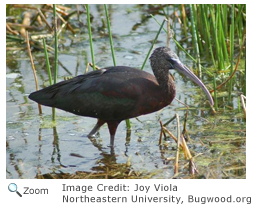 The glossy ibis is about 20 inches in length with a wingspan of about three feet. It has a long, dark gray bill that is curved down that it uses to feel for prey. It has dark purple to black feathers on its head, neck, back, and belly. Its legs are long and black, and its wings and tail are a shiny green. In the breeding season, the glossy ibis has rusty-red feathers and a pale blue line around its face. The glossy ibis is about 20 inches in length with a wingspan of about three feet. It has a long, dark gray bill that is curved down that it uses to feel for prey. It has dark purple to black feathers on its head, neck, back, and belly. Its legs are long and black, and its wings and tail are a shiny green. In the breeding season, the glossy ibis has rusty-red feathers and a pale blue line around its face.
Range 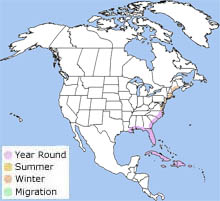 The glossy ibis is found along the east coast of the United States from Maine to Texas. In the winter, it lives from the Carolinas south to Florida and along the Gulf Coast to Texas. It is also found in Central America, South America, Africa, southern Eurasia, and Australia. The glossy ibis is found along the east coast of the United States from Maine to Texas. In the winter, it lives from the Carolinas south to Florida and along the Gulf Coast to Texas. It is also found in Central America, South America, Africa, southern Eurasia, and Australia.
Habitat
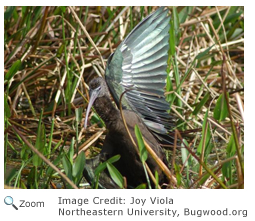 The glossy ibis is found in a variety of wetlands including marshes, estuaries, coastal bays, flooded fields, and swamps. The glossy ibis is found in a variety of wetlands including marshes, estuaries, coastal bays, flooded fields, and swamps.
|
|
Diet
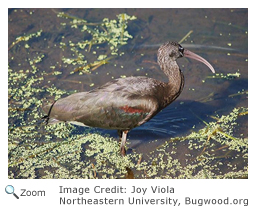 The glossy ibis probes in the mud and silt with its bill looking for prey like the fiddler crabs, crawfish, insects, and small snakes. The glossy ibis probes in the mud and silt with its bill looking for prey like the fiddler crabs, crawfish, insects, and small snakes.
Life Cycle
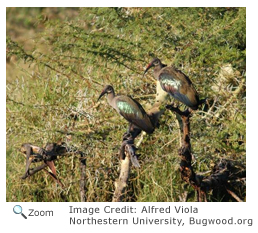 The glossy ibis lays three or four eggs in a nest of twigs and sticks. The nests are usually built in trees or bushes but are sometimes built on the ground. The glossy ibis builds its nest in colonies that include the nests of other ibises as well as the nests of other species like egrets and herons. Occasionally, the glossy ibis uses an abandoned snowy egret nest. The glossy ibis is very territorial during nesting. The glossy ibis lays three or four eggs in a nest of twigs and sticks. The nests are usually built in trees or bushes but are sometimes built on the ground. The glossy ibis builds its nest in colonies that include the nests of other ibises as well as the nests of other species like egrets and herons. Occasionally, the glossy ibis uses an abandoned snowy egret nest. The glossy ibis is very territorial during nesting.
The eggs take about three weeks to hatch. The female and male incubate the egg, but the female does most of the work. Both parents feed the chicks. The chicks fledge in about a month. They leave the nest and start to forage for food with their parents when they are two months old.
Behavior 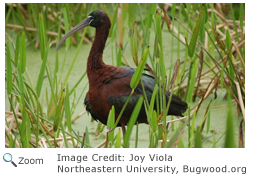 The glossy ibis is relatively new to North America. It came here from Africa. It probably flew across the Atlantic to South America and then slowly expanded its range to North America. The glossy ibis is relatively new to North America. It came here from Africa. It probably flew across the Atlantic to South America and then slowly expanded its range to North America.
|